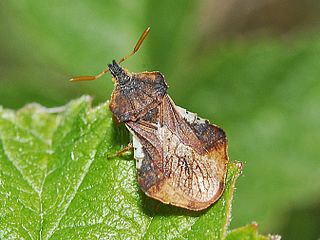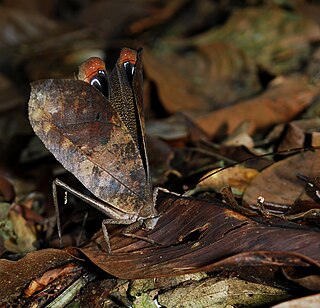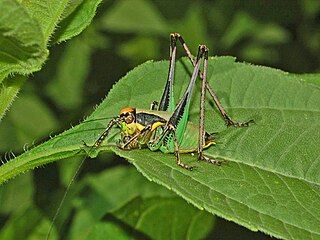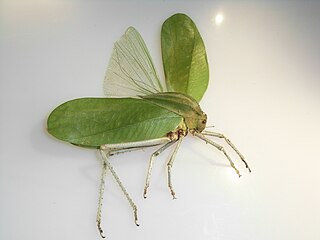
Insects in the family Tettigoniidae are commonly called katydids or bush crickets. They have previously been known as "long-horned grasshoppers". More than 8,000 species are known. Part of the suborder Ensifera, the Tettigoniidae are the only extant (living) family in the superfamily Tettigonioidea.

The cicadas are a superfamily, the Cicadoidea, of insects in the order Hemiptera. They are in the suborder Auchenorrhyncha, along with smaller jumping bugs such as leafhoppers and froghoppers. The superfamily is divided into two families, the Tettigarctidae, with two species in Australia, and the Cicadidae, with more than 3,000 species described from around the world; many species remain undescribed. Nearly all of cicada species are annual cicadas with the exception of the few North American periodical cicada species, genus Magicicada, which in a given region emerge en masse every 13 or 17 years.

The bush stone-curlew or bush thick-knee is a large, ground-dwelling bird endemic to Australia. Its favoured habitat is open plains and woodlands, where it stalks slowly at night in search of invertebrates such as insects. Its grey-brown coloration is distinguished by dark streaks, its eyes are large and legs are long. It is capable of flight, but relies on the camouflage of its plumage to evade detection during the day; the bush curlew adopts a rigid posture when it becomes aware of an observer. Both sexes care for two eggs laid on the bare ground, usually sited near bush in a shaded position or next to a fallen branch.

Ant mimicry or myrmecomorphy is mimicry of ants by other organisms; it has evolved over 70 times. Ants are abundant all over the world, and potential predators that rely on vision to identify their prey, such as birds and wasps, normally avoid them, because they are either unpalatable or aggressive. Some arthropods mimic ants to escape predation, while some predators of ants, especially spiders, mimic them anatomically and behaviourally in aggressive mimicry. Ant mimicry has existed almost as long as ants themselves; the earliest ant mimics in the fossil record appear in the mid-Cretaceous alongside the earliest ants.

Extatosoma tiaratum, commonly known as the spiny leaf insect, the giant prickly stick insect, Macleay's spectre, or the Australian walking stick, is a large species of Australian stick insect. The species has the Phasmid Study Group number PSG9.

Eurycnema goliath, commonly known as the goliath stick insect, or the regal stick insect, is a large species of stick insect in the family Phasmatidae, endemic to Australia and considered one of the largest species of stick insects in the country. The species has the Phasmid Study Group number PSG14.
Deroplatys desiccata, known by the common name giant dead leaf mantis, is a praying mantis from Southeast Asia. This is the type species of genus Deroplatys.

Crickets are orthopteran insects which are related to bush crickets, and, more distantly, to grasshoppers. In older literature, such as Imms, "crickets" were placed at the family level, but contemporary authorities including Otte now place them in the superfamily Grylloidea. The word has been used in combination to describe more distantly related taxa in the suborder Ensifera, such as king crickets and mole crickets.

Pulchriphyllium bioculatum, Gray's leaf insect, is a leaf insect of the family Phylliidae native to tropical Asia as well as Madagascar, Mauritius and the Seychelles. It was first described by George Robert Gray in 1832 and was the first phasmid he discovered. Leaf insects have extremely flattened, irregularly shaped bodies, wings, and legs. They are usually about 5–10 cm long. They are called leaf insects because their large, leathery forewings have veins that look similar to the veins on the particular type of leaves they inhabit. Its scientific name bioculatum means "two-eyed" and refers to the two dots located on the abdomen just in this species.

Phymata crassipes is a species of assassin and thread-legged bugs belonging to the family Reduviidae, subfamily Phymatinae.

Pterochroza ocellata, the peacock katydid, is an insect in the family Tettigoniidae from the Amazon rainforest in South America. It is the only species in the genus Pterochroza. The species is a leaf-mimic katydid; when it is in repose its camouflage resembles a diseased or dead leaf. The katydid owes both its common name and its specific epithet to its startle display, in which it shows false eye spots on its normally hidden hind wings.

Phaneroptera nana, common name southern sickle bush-cricket, is a species in the family Tettigoniidae and subfamily Phaneropterinae. It has become an invasive species in California where it may be called the Mediterranean katydid.

Eupholidoptera chabrieri is a species of katydid belonging to the subfamily Tettigoniinae.

Yersinella raymondii, common name Raymond's bush-cricket, is a species of "katydids crickets" belonging to the family Tettigoniidae subfamily Tettigoniinae. The scientific name Yersinella comes from the name of the entomologist who has described the species in 1860.

Orchelimum gladiator is a species of katydid that has the common names gladiator meadow katydid and gladiator katydid.

Cleora scriptaria, the kawakawa looper moth, is a moth in the family Geometridae endemic to New Zealand.

Chlorobalius is a monotypic genus of Australian bush crickets (katydids) in the tribe Terpandrini containing the single species Chlorobalius leucoviridis, sometimes known as the spotted predatory katydid. C. leucoviridis is a predator and is an acoustic aggressive mimic of cicadas; by imitating the sounds and movements made by female cicadas, it lures male cicadas to within its reach and then eats them.

Caedicia simplex is a species of bush cricket or katydid, native to New Zealand and Australia. A common name is the "common garden katydid".

Erechthis levyi, the blue-faced katydid or Eleuthera rhino katydid, is a katydid found in The Bahamas. Currently, it is described from specimens collected only on the island of Eleuthera. They are light brown in color throughout the body, but exhibit a bright turquoise-blue face and bear a prominent spine on the vertex of the head between the eyes, hence the common names. It is tentatively considered an endemic species to The Bahamas, as no specimens are recorded from Cuba or Hispaniola, where other Erechthis species occur. The species was named in honor of Leon Levy, a prominent Wall Street financier and philanthropist who spent much time on Eleuthera and was an avid admirer of the island's flora and natural beauty.

Siliquofera is a genus of bush cricket in the subfamily Phyllophorinae that includes only one species, Siliquofera grandis, which is fairly common and widespread in rainforest canopies of New Guinea and nearby smaller islands, and seemingly rare in Australia where only found in the remote Iron Range region. This very well-camouflaged, green and leaf-like bush cricket is one of the world's largest Orthoptera, with adults typically having a length of 10.7–13 cm (4.2–5.1 in) and a wingspan of 25–27 cm (9.8–10.6 in); it can weigh more than 30 g (1.1 oz).




















